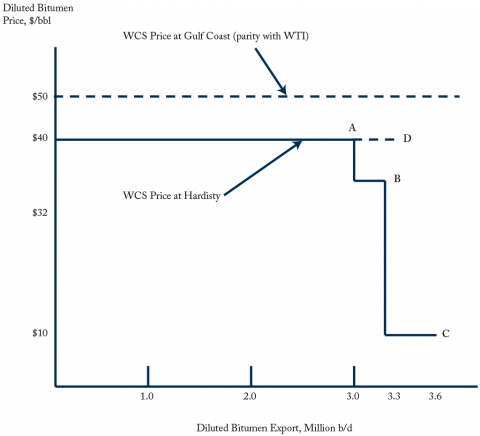From: Brian Livingston
To: Concerned Albertans
Date: April 4, 2019
Re: Alberta can boost revenues from crude production by giving financial assistance for rail transport
Curtailment of heavy oil production and shipment by rail have been in the news recently, and the link between them bears examination as the Alberta government and industry decide on their respective next steps.
The root cause of curtailment is a market failure, namely the inability to build pipelines to export heavy oil out of Alberta. Curtailment is intended to reduce heavy oil production so exports just equal pipeline plus rail export capacity.
Furthermore, the intended consequence of curtailment is to increase the Western Canadian Select (WCS) price of Alberta heavy oil to the benchmark price for Maya blend at the Gulf Coast, less the marginal cost of getting the heavy oil to that market. Since rail is more expensive than pipelines, rail is the marginal form of transport and thus should determine the WCS price.
The Figure shows the interaction of various assumptions for quantities of heavy oil shipments and the effect on WCS price.
The assumptions for the plot are that domestic Alberta consumption of heavy oil (mostly upgrading) is 1 million barrels per day (b/d), the amount of diluted bitumen heavy oil for export assuming no curtailment is 3.6 million b/d, with 3.0 million b/d of pipeline export capacity and 0.3 million b/d of rail export capacity. The tariff for pipeline shipment is $10/bbl, and for rail shipment is $18/bbl. Any shipments in excess of pipeline and rail capacity either pile up in storage or are transported out of Alberta by truck at a cost of up to $40/bbl.
The assumption is that Maya blend trades at parity to WTI. Maya has recently been trading at a premium to WTI because Gulf Coast refineries that use heavy oil as feedstock have faced a recent shortfall in supply from Venezuela, Mexico and Saudi Arabia.
If production is less than pipeline capacity, all production would be transported by pipeline. The WCS price at Hardisty would be $40/bbl (i.e., WTI price of $50/bbl minus $10/bbl). This is point A, which is where the heavy oil market quantity and price is today. Furthermore, if pipeline capacity had expanded to match increased production (point D in the plot), the WCS price would still be $40/bbl.
However, since pipeline capacity is insufficient, a production increase to 3.3 million b/d means that 0.3 million b/d would have to be exported by rail. The WCS price should fall to $32/bbl, (i.e., $50/bbl minus $18/bbl cost for rail). This is point B.
To maximize revenues from oil royalities, the Alberta government’s aim would be to maintain production at point B (where rail economics determine the local WCS price). The recent increases in the curtailment limit indicates that this is what the government of Alberta is trying to do. It makes sense to move to Point B, since it would be very unfortunate to have curtailed shut in capacity and idle rail cars at the same time.
If curtailment were ended and production further increased to 3.6 million b/d (and if storage is full), the WCS price would fall precipitously since the marginal mode of tranport will be by truck at $40/bbl. This is point C, and was arguably the situation last November when the WTI-WCS gap widened to an historic high.
However, the price at point B implies a cost for the Alberta government. The $32/bbl price at point B will mean that all 3.3 million b/d of export will use a price of $32/bbl for royalty calculation purposes. This contrasts with point D where 3.3 million b/d would use a price of $40/bbl for royalty calculation. The total revenue at point D is $132 million/day, versus $105.6 million/day at point B. The difference is $26.4 million per day or $9.636 billion per year.
Assuming 50 percent of production is pre-payout (1 percent gross royalty) and the other half is post-payout (25 percent net royalty), the increase in royalties for Alberta would be about $1.2 billion per year. Alberta would also benefit from its 12 percent income tax on the increased taxable income of producers – about $0.5 billion per year of additional corporate taxes (assuming 50 percent of income is taxable).
The challenge is how to increase production so rail capacity is used, yet keep the WCS discount at $10/bbl. One solution might be for the Alberta government to provide financial assistance to rail shippers by capping the rail cost at $10/bbl. Since the marginal cost of rail would now be $10/bbl, this would keep the WCS discount at $10/bbl. The cost of such financial assistance would be in the order of $900 million per year ($18 minus $10/bbl times 300,000 bbl/day times 365 days). Given the uplift in Alberta government revenues of $1.7 billion per year (royalty plus corporate tax), it still means the Alberta government would have a net benefit of $800 million per year.
The actual mechanics of providing this financial assistance would require both new contracts as well as amendments to existing arrangements for producers who have already contracted rail capacity.
Arguably, the federal government should also step up to provide financial assistance, since Ottawa bears some responsibility for the delays in pipeline capacity for oil production. Such assistance might be of more direct value to industry than the $1.6 billion loans and grants assistance announced in December of 2018. It would be a specific positive step to increase market access and immediately enhance the value Alberta gets for its oil.
Brian Livingston is Executive Fellow at the School of Public Policy at the University of Calgary.
To send a comment or leave feedback, email us at blog@cdhowe.org.
The views expressed here are those of the author. The C.D. Howe Institute does not take corporate positions on policy matters.






